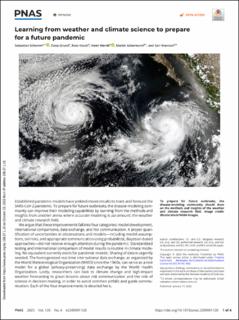| dc.contributor.author | Schemm, Sebastian | |
| dc.contributor.author | Grund, Dana | |
| dc.contributor.author | Knutti, Reto | |
| dc.contributor.author | Wernli, Heini | |
| dc.contributor.author | Ackermann, Martin | |
| dc.contributor.author | Evensen, Geir | |
| dc.date.accessioned | 2023-11-24T12:09:18Z | |
| dc.date.available | 2023-11-24T12:09:18Z | |
| dc.date.created | 2023-04-14T12:22:45Z | |
| dc.date.issued | 2023 | |
| dc.identifier.citation | Proceedings of the National Academy of Sciences of the United States of America. 2023, 120 (4), . | en_US |
| dc.identifier.issn | 0027-8424 | |
| dc.identifier.uri | https://hdl.handle.net/11250/3104543 | |
| dc.description.abstract | Established pandemic models have yielded mixed results to track and forecast the SARS-CoV-2 pandemic. To prepare for future outbreaks, the disease-modeling community can improve their modeling capabilities by learning from the methods and insights from another arena where accurate modeling is paramount: the weather and climate research field. To prepare for future outbreaks, the disease-modeling community should draw on the methods and insights of the weather and climate research field. Image credit: Shutterstock/NASA Images. We argue that these improvements fall into four categories: model development, international comparisons, data exchange, and risk communication. A proper quantification of uncertainties in observations and models—including model assumptions, tail risks, and appropriate communication using probabilistic, Bayesian-based approaches—did not receive enough attention during the pandemic. Standardized testing and international comparison of model results is routine in climate modeling. No equivalent currently exists for pandemic models. Sharing of data is urgently needed. The homogenized real-time international data exchange, as organized by the World Meteorological Organization (WMO) since the 1960s, can serve as a role model for a global (privacy-preserving) data exchange by the World Health Organization. Lastly, researchers can look to climate change and high-impact weather forecasting to glean lessons about risk communication and the role of science in decision-making, in order to avoid common pitfalls and guide communication. Each of the four improvements is detailed here. | en_US |
| dc.language.iso | eng | en_US |
| dc.rights | Attribution-NonCommercial-NoDerivatives 4.0 Internasjonal | * |
| dc.rights.uri | http://creativecommons.org/licenses/by-nc-nd/4.0/deed.no | * |
| dc.subject | Ensemble based methods | en_US |
| dc.subject | Ensemble-based methods | en_US |
| dc.subject | Modelling uncertainty | en_US |
| dc.subject | Modelling uncertainty | en_US |
| dc.subject | Modellering | en_US |
| dc.subject | Modelling | en_US |
| dc.subject | Pandemi | en_US |
| dc.subject | Pandemic | en_US |
| dc.title | Learning from weather and climate science to prepare for a future pandemic | en_US |
| dc.title.alternative | Learning from weather and climate science to prepare for a future pandemic | en_US |
| dc.type | Peer reviewed | en_US |
| dc.type | Journal article | en_US |
| dc.rights.holder | © 2023 the Author(s) | en_US |
| dc.description.version | publishedVersion | en_US |
| cristin.ispublished | true | |
| cristin.fulltext | original | |
| cristin.qualitycode | 2 | |
| dc.identifier.doi | 10.1073/pnas.2209091120 | |
| dc.identifier.cristin | 2140861 | |
| dc.source.journal | Proceedings of the National Academy of Sciences of the United States of America | en_US |
| dc.source.volume | 120 | en_US |
| dc.source.issue | 4 | en_US |
| dc.source.pagenumber | 0 | en_US |
| dc.subject.nsi | VDP::Helsefag: 800 | en_US |
| dc.subject.nsi | VDP::Health sciences: 800 | en_US |

